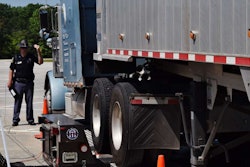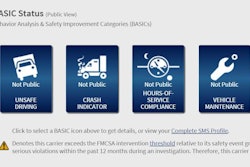 Roadside inspections and violation data would be much larger factors in determining a carriers’ fitness to operate, rather than the current system’s heavy use of on-site compliance reviews.
Roadside inspections and violation data would be much larger factors in determining a carriers’ fitness to operate, rather than the current system’s heavy use of on-site compliance reviews.A proposed rule issued in January by the Federal Motor Carrier Safety Administration will, if implemented, allow the agency to issue about 150 times more carrier safety assessments a year than it does now, said FMCSA reps in a media update held about its proposed Safety Fitness Determination rule.
Joe DeLorenzo, head of enforcement and compliance for FMCSA, spoke briefly in a conference call with trucking industry media Thursday, April 7, touting the rule’s ability to expand the agency’s ability to target unsafe carriers and addressing concerns about the rule’s relationship to the December-enacted FAST Act highway bill.
The rule will in short do away with the three-tier Satisfactory, Conditional and Unsatisfactory carrier rating system and replace it with a two-tier system, Fit and Unfit. It will also change the way the agency determines those ratings, concentrating more on roadside inspection and violation data rather than on-site compliance reviews.
Industry groups since the January issuance of the proposed Safety Fitness rule have argued the agency violated provisions of the FAST Act by moving forward with the SFD rule. A group of 33 lawmakers in the U.S. House also have taken aim at the rule proposal. The trucking groups and group of lawmakers argue the agency should have implemented the Compliance, Safety, Accountability reforms required by the FAST Act before issuing the Safety Fitness proposal.
The agency, however, argues otherwise, saying the FAST Act did not limit its ability to proceed with the rule. “The way that the FAST Act is set up — it was not designed [and] is not written in such a way that prevents us from moving forward on any rulemaking,” he said. The limitations included in the FAST Act are only related to the use of CSA’s percentile rankings and alerts, he said, which the rule does not mention except to “give context,” DeLorenzo said.
If the National Academies of Science, the group tasked with studying the CSA program and issuing recommendations to the agency about fixing the system, comes back with recommendations regarding the SFD rule, FMCSA will incorporate them into the rule when its developing the rule’s final version, DeLorenzo said.
The agency will also take into account feedback from industry stakeholders about the rule when crafting the final draft, and DeLorenzo encouraged those in the industry like carriers and owner-operators to offer feedback. The comment period is open until May 23, and comments can be made at this link.
DeLorenzo said one of the SFD rule’s main objectives is to expand the agency’s ability to target unsafe carriers by leaning more heavily on roadside inspection data and less heavily on on-site investigations. “With our limited resources we’re only able to get to a very small percentage of the companies that are out there to make these determinations,” he said. “Also, because of that, the ratings are often not current because we have such limited resources and ability to conduct investigations.”
The SFD rule will allow the agency to target and weed out carriers most at risk for crashes, DeLorenzo said. Per FMCSA’s calculations, the 300 carriers that would currently fall under an Unfit designation have a crash risk four times greater than the national average.
Currently, the agency conducts about 15,000 on-site investigations a year, DeLorenzo said. When the Safety Fitness rule takes effect, FMCSA will be able to assess about 75,000 carriers a month, per its estimates.
Carriers deemed Unfit to operate will have an opportunity to implement corrective actions and enter into an agreement with the agency to continue operation, DeLorenzo said.












